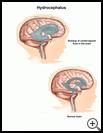
Hydrocephalus
________________________________________________________________________
KEY POINTS
- Hydrocephalus is a buildup of fluid in the brain. Normally, as new fluid is made, the old fluid is absorbed into the bloodstream. If extra fluid builds up, it puts pressure on the brain.
- If not treated, hydrocephalus can become serious, causing brain damage or death. The most common treatment is surgery to put a tube called a shunt inside your child’s body to drain the extra fluid from the brain.
- Follow your child’s healthcare provider's instructions. Ask your provider what symptoms or problems you should watch for and what to do if your child has them.
________________________________________________________________________
What is hydrocephalus?
Hydrocephalus is a buildup of fluid in the brain. The fluid is called cerebrospinal fluid (CSF). CSF is made in the brain and protects the brain and spinal cord. Normally, as new fluid is made, the old fluid is absorbed into the bloodstream. If extra fluid builds up, it puts pressure on the brain. People commonly refer to hydrocephalus as water on the brain.
Hydrocephalus is usually a life-long condition that may be mild or serious. In mild cases, your child may have normal intelligence and a normal lifespan. In serious cases, the pressure on the brain may damage the brain and cause problems with learning, growth, and behavior.
What is the cause?
Hydrocephalus happens most often in newborns. It can happen when the flow of fluid inside the brain is blocked, when extra fluid is made in the brain, or when the fluid cannot be reabsorbed into the bloodstream. Problems that can cause hydrocephalus include birth defects, head injury, a tumor, infection, or bleeding in the brain.
What are the symptoms?
Symptoms in a newborn may include:
- A bulging soft spot on the top of the head
- An unusually large head
- Vomiting, sleepiness, and irritability
- Seizures
- Eyes that tend to look down
- Delays in development
Symptoms in an older child may include:
- Problems with balance, coordination, or walking
- Headache followed by vomiting and nausea, especially first thing in the morning
- Eyes that tend to look down
- Blurred or double vision
- Sleepiness, tiredness, irritability, or changes in personality
How is it diagnosed?
Your healthcare provider will ask about your child’s symptoms and medical history and examine your child. Your provider will suspect hydrocephalus if your child's head seems to be getting bigger too fast. Tests may include:
- Ultrasound, which uses sound waves to show pictures of the brain
- CT scan, which uses X-rays and a computer to show detailed pictures of the brain
- MRI, which uses a strong magnetic field and radio waves to show detailed pictures of the brain
Sometimes hydrocephalus can be diagnosed with one of these scans before a child is born.
How is it treated?
If not treated, hydrocephalus can become serious, causing brain damage or death. Treatment for hydrocephalus depends on the cause. The most common treatment is surgery to put a tube inside your child’s body to drain the extra fluid from the brain. The tube, called a shunt, drains the fluid into the abdomen (belly) or heart. Your child may need several surgeries throughout grown, or if the shunt gets blocked or infected.
Some children may be able to have surgery that will allow the fluid to flow into other parts of the brain where it can be absorbed easily.
How can I take care of my child?
Follow your child’s healthcare provider's instructions. Ask your provider:
- How and when you will get your child’s test results
- How long it will take for your child to recover
- If there are activities your child should avoid and when your child can return to normal activities
- How to take care of your child at home
- What symptoms or problems you should watch for and what to do if your child has them
Make sure you know when your child should come back for a checkup.
For more information, contact:
- Hydrocephalus Association
888-598-3789
https://www.hydroassoc.org
Last modified: 2020-09-30
Last reviewed: 2018-07-05

